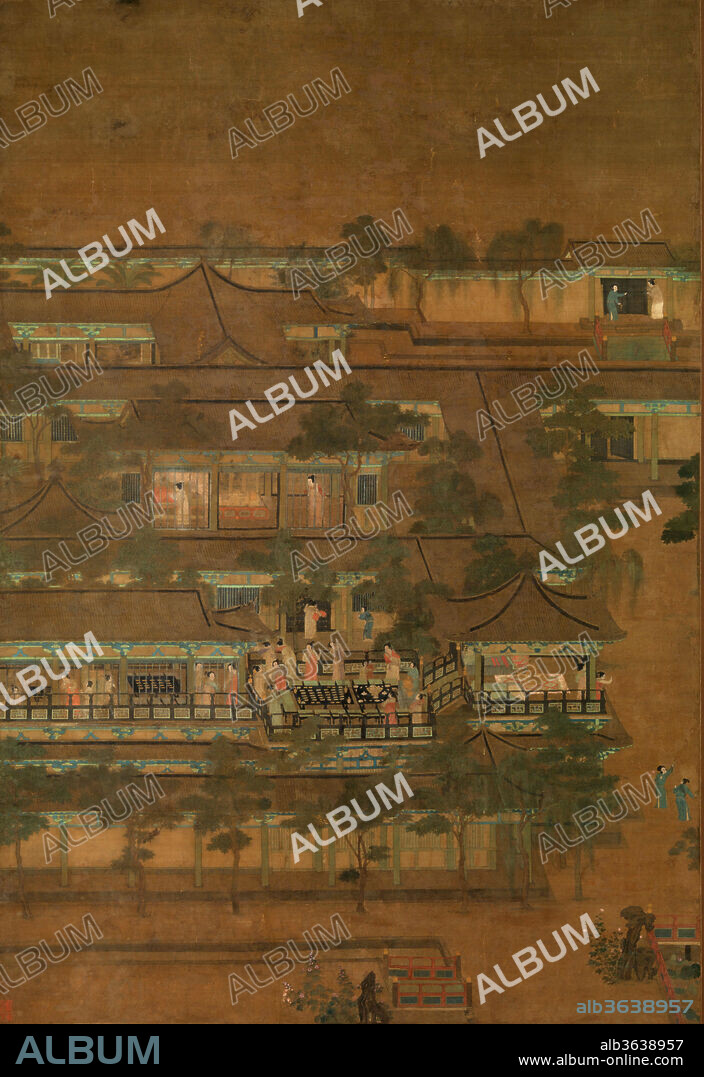alb3638957
UNIDENTIFIED ARTIST CHINESE, ACTIVE LATE 10TH-11TH CENTURY. Palace banquet

|
Add to another lightbox |
|
Add to another lightbox |



Title:
Palace banquet
Caption:
Palace banquet. Artist: Unidentified Artist Chinese, active late 10th-11th century. Culture: China. Dimensions: Image: 63 5/8 × 43 5/8 in. (161.6 × 110.8 cm)
Overall with mounting: 10 ft. 4 in. × 44 3/8 in. (315 × 112.7 cm)
Overall with knobs: 10 ft. 4 in. × 49 1/2 in. (315 × 125.7 cm).
This large painting is one of the earliest surviving examples of the "ruled-line" (jiehua) genre of architectural renderings. It offers an intimate view of the women's quarters of a palace where elegant rooms face onto private courtyards graced with trees and blossoming lotus, an indication of the summer season. Activity centers around a second-story terrace where women at a banqueting table point skyward or concentrate on threading needles. On the seventh day of the seventh month, women traditionally decorated their homes, set out fruits, and competed in threading needles as part of the festivities celebrating the one night each year when the Herd Boy and the Weaving Maid, legendary lovers immortalized as constellations, are allowed to meet. Behind the banquet, a woman knocks at a gate, beyond which, to the left, another woman claps her hands beside a bed to awaken its occupant. A third woman, to the right, gazes out beneath two trees that have grown intertwined--a symbol, perhaps, of the fateful union about to occur. At the upper right, two women prepare to open the gate to a visitor.
The painting alludes to the love affair between the Tang emperor Xuanzong (r. 712-56) and his consort, Yang Guifei, who famously slept all day to arise refreshed at night. In 755, a rebellion broke out as a consequence of the emperor's inattention to rulership. Xuanzong was forced to flee, and the palace guards blamed Yang Guifei for the insurrection. They forced the emperor to execute her before escorting him to safety. Bai Juyi's (772-846) epic poem, The Song of Everlasting Sorrow, describes the tragic story, beginning with the fateful tryst alluded to by the painting. Both poem and painting may be read as admonitions against neglecting state affairs.
Technique/material:
Hanging scroll; ink and color on silk
Period:
Five Dynasties (907-960) or Northern Song (960-1127) dynasty
Museum:
Metropolitan Museum of Art, New York, USA
Credit:
Album / Metropolitan Museum of Art, NY
Releases:
Model: No - Property: No
Rights questions?
Rights questions?
Image size:
2560 x 3726 px | 27.3 MB
Print size:
21.7 x 31.5 cm | 8.5 x 12.4 in (300 dpi)
Keywords:
ASIA • ASIAN ART • CHINA • FIVE DYNASTIES (907-960) OR NORTHERN SONG (960-1127) DYNASTY • HANGING SCROLL; INK AND COLOR ON SILK • HANGING SCROLLS • INK • METROPOLITAN MUSEUM OF ART, NEW YORK, USA • PAINTINGS • SCROLL PAINTINGS • SCROLLS • SILK • TEXTILES: SILK • UNIDENTIFIED ARTIST CHINESE, ACTIVE LATE 10TH-11TH CENTURY
 Pinterest
Pinterest Twitter
Twitter Facebook
Facebook Copy link
Copy link Email
Email

